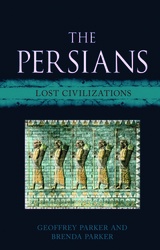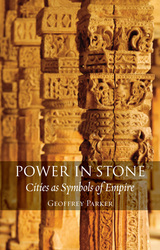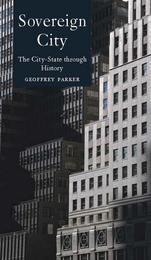3 books about Parker, Geoffrey

The Persians
Lost Civilizations
Brenda Parker and Geoffrey Parker
Reaktion Books, 2017
Now in paperback, this is a history of an incomparable culture whose influence can still be seen, millennia later, in modern-day Iran and the wider Middle East.
During the first and second millennia BCE a swathe of nomadic peoples migrated outward from Central Asia into the Eurasian periphery. One group of these people would find themselves encamped in an unpromising, arid region just south of the Caspian Sea. From these modest and uncertain beginnings, they would go on to form one of the most powerful empires in history: the Persian Empire. In this book, Geoffrey and Brenda Parker tell the captivating story of this ancient civilization and its enduring legacy to the world.
The authors examine the unique features of Persian life and trace their influence throughout the centuries. They examine the environmental difficulties the early Persians encountered and how, in overcoming them, they were able to develop a unique culture that would culminate in the massive, first empire, the Achaemenid Empire. Extending their influence into the maritime west, they fought the Greeks for mastery of the eastern Mediterranean—one of the most significant geopolitical contests of the ancient world. And the authors paint vivid portraits of Persian cities and their spectacular achievements: intricate and far-reaching roadways, an astonishing irrigation system that created desert paradises, and, above all, an extraordinary reflection of the diverse peoples that inhabited them.
During the first and second millennia BCE a swathe of nomadic peoples migrated outward from Central Asia into the Eurasian periphery. One group of these people would find themselves encamped in an unpromising, arid region just south of the Caspian Sea. From these modest and uncertain beginnings, they would go on to form one of the most powerful empires in history: the Persian Empire. In this book, Geoffrey and Brenda Parker tell the captivating story of this ancient civilization and its enduring legacy to the world.
The authors examine the unique features of Persian life and trace their influence throughout the centuries. They examine the environmental difficulties the early Persians encountered and how, in overcoming them, they were able to develop a unique culture that would culminate in the massive, first empire, the Achaemenid Empire. Extending their influence into the maritime west, they fought the Greeks for mastery of the eastern Mediterranean—one of the most significant geopolitical contests of the ancient world. And the authors paint vivid portraits of Persian cities and their spectacular achievements: intricate and far-reaching roadways, an astonishing irrigation system that created desert paradises, and, above all, an extraordinary reflection of the diverse peoples that inhabited them.
[more]

Power in Stone
Cities as Symbols of Empire
Geoffrey Parker
Reaktion Books, 2014
From ancient Persia to the Third Reich, imperial powers have built cities in their image, seeking to reflect their power and influence through a show of magnificence and a reflection of their values. Statues, pictures, temples, palaces—all combine to produce the necessary justification for the wielding of power while intimidating opponents. In Power in Stone, Geoffrey Parker traces the very nature of power through history by exploring the structural symbolism of these cities.
Traveling from Persepolis to Constantinople, Saint Petersburg to Beijing and Delhi, Parker considers how these structures and monuments were brought together to make the most powerful statement and how that power was wielded to the greatest advantage. He examines imperial leaders, their architects, and their engineers to create a new understanding of the relationship among buildings, design, and power. He concludes with a look at the changing nature of power in the late twentieth and twenty-first centuries and the way this is reflected symbolically in contemporary buildings and urban plans. With illuminating images, Power in Stone is a fascinating history of some of the world’s most intriguing cities, past and present.
Traveling from Persepolis to Constantinople, Saint Petersburg to Beijing and Delhi, Parker considers how these structures and monuments were brought together to make the most powerful statement and how that power was wielded to the greatest advantage. He examines imperial leaders, their architects, and their engineers to create a new understanding of the relationship among buildings, design, and power. He concludes with a look at the changing nature of power in the late twentieth and twenty-first centuries and the way this is reflected symbolically in contemporary buildings and urban plans. With illuminating images, Power in Stone is a fascinating history of some of the world’s most intriguing cities, past and present.
[more]

Sovereign City
The City-State Ancient and Modern
Geoffrey Parker
Reaktion Books, 2004
The city has had a rich and tumultuous history, evolving from a powerful political entity in ancient times to its modern role as a local hub of tourism and commerce. Sovereign City examines the nature of the city's ever-changing status, as Geoffrey Parker investigates the city-state as a geopolitical form and explores its distinctive niche within different types of states. This probing work analyzes the various forms of city-states throughout world history, from the Greek polis, which Plato and Aristotle considered the perfect type of state, to the Roman imperial capital, to the political role of the city in early Islamic society. Parker also considers the revival of the European city-state in late medieval and Renaissance Italy and northern Europe, which culminated in the Hanseatic League, and how the rise of the nation-state contributed to the decline of the city-state.
Sovereign City is a wide-ranging and vigorous examination that seeks to understand the role of the city-state from the birth of Western civilization through its re-emergence at the dawn of the twenty-first century in the Far East and Islamic world.
Sovereign City is a wide-ranging and vigorous examination that seeks to understand the role of the city-state from the birth of Western civilization through its re-emergence at the dawn of the twenty-first century in the Far East and Islamic world.
[more]
READERS
Browse our collection.
PUBLISHERS
See BiblioVault's publisher services.
STUDENT SERVICES
Files for college accessibility offices.
UChicago Accessibility Resources
home | accessibility | search | about | contact us
BiblioVault ® 2001 - 2024
The University of Chicago Press









